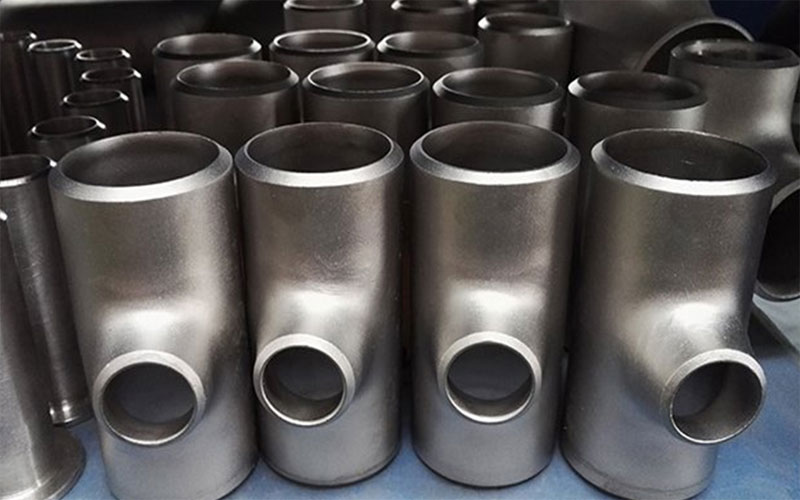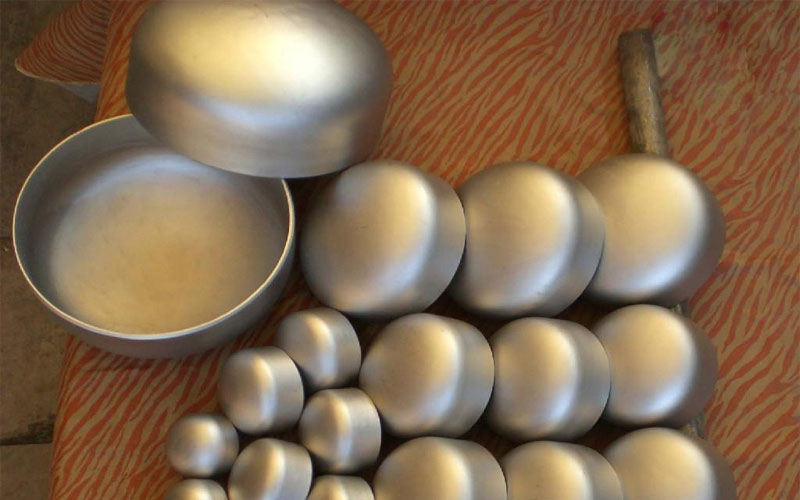Buttweld fittings

Buttweld fittings are used to connect the piping section, parts or change the direction of the flow to the piping system. They are to be welded on the ends of the pipe, making it smooth and uninterrupted, which helps to get a strong leak-free connection with a seam or joints. The word “buttweld” describes the process by which the fitting is welded into the pipe, directly a high-intelligence, permanent connection.
Buttweld fittings are widely applied in many industries, such as oil and gas, chemical processing, power generation, water treatment and HVAC systems, where high strength, pressure resistance and stability are required.
Key Features of Buttweld Fittings:
- Smooth Interior Surface: Since the buttweld fitting is welded directly on the pipe without any threading, they create a smooth, uninterrupted interior surface, which reduces the ability of disturbance or resistance to the fluid throughout the system.
- High Strength: Welding of buttweld fitting produces an extremely strong, rugged joint that is capable of tolerating high pressure, severe temperature and mechanical stresses.
- Seamless Connection: There is no compromise of a spontaneous relationship between fittings and pipes, without leaks and therefore system integrity.
- Corrosion Resistance: Buttweld fittings from alloys such as stainless steel are immune for corrosion and corrosion, which are ideal for aggressive high-corrosive environments.
- Versatility: Find the applications for a range of available shapes (elbow, tees, reducer, caps, etc.), buttweld fittings for various pipes sizes and uses.
Types of Buttweld Fittings:
- Elbows:
- Function: Used to change the direction of the flow within a piping system. The standard types of the elbow are 90 °, 45 ° and 180 ° The elbow, although special angles can also arise.
- Application: Often used in pipelines where fluid or gas routing requires directional changes.
- Variants: Long Radius (LR) and Short Radius (SR) depending on the elbow, size and application.
- Tees:
- Function: To divide a pipeline into two separate lines or to merge two lines simultaneously. A tea fitting has three holes and is usually used when adding a branch to a pipeline.
- Application: Many times the system, used in plumbing and distribution systems.
- Variants: Equal tees (all three openings are similar in size) and reducing tees (one opening is smaller than the other two).
- Reducers:
- Function: The act of joining the pipe of different diameter. Reducing reducers convert the flow from a large pipe into a small (or vice).
- Application: Often used where pressure or flow should be controlled by decreasing or increased in the size of the pipe.
- Variants: Concentric Reducers (same centerline) and Eccentric Reducers (off-centerline).
- Caps:
- Function: Used to seal the end of a pipe to avoid fluid or gas leakage. CAPS is usually employed in maintenance operations or if a piping section is required to be temporarily separated.
- Application: Planned in pipelines or parts where the flow should be stopped or temporarily sealed.
- Stub Ends:
- Function: Lap is used in combination with joint flanges, the stub ends are welded into the pipe and a means of attaching a untouched edge without welding a straight edge on the pipe.
- Application: Found in applications where easy assembly and disassembly are essential.
- Collars:
- Function: A pipe is used to strengthen the connection or joint. Adding additional reinforcement, the collar is welded at the point of the connection.
- Application: Mostly used where pipes require further strength, especially in high pressure pipes.
Materials Used for Buttweld Fittings:
The material applied to Buttweld fitting is usually similar to the material of the pipe on which they are going to fit. Some of the material commonly used for butter fittings are:
- Carbon Steel:
- The most popular content for buttweld fitting is carbon steel. It is economical and suitable for general use in general to moderate pressure systems. Carbon steel fittings are applied in services where corrosion is not enough problem.
- Grades: ASTM A234 WPB, ASTM A420 WPL6.
- Stainless Steel:
- Stainless steel buttweld fittings are used in industries requiring resistance to corrosion, oxidation, and high temperatures, such as food processing, chemical, and pharmaceutical industries.
- Grades: Common grades include 304, 316, 321, and 310, depending on the specific requirements of the application.
- Alloy Steel:
- Alloy steel buttweld fittings are used in high pressure and high temperature applications. They are designed to tolerate harsh conditions, including experienced in power plants or oil and gas sectors.
- Grades: ASTM A234 WP1, ASTM A234 WP22, etc.
- Nickel Alloys:
- Nickel alloys, such as Monel, Inconel, and Hastelloy, are used for highly corrosive environments where standard stainless steel fittings would not suffice.
- Applications: Marine, chemical processing, and aerospace industries.
- Ductile Iron and Cast Iron:
- These are applied to low pressure piping systems, sometimes in water supply or sewerage management, where the pipe is not exposed in severe conditions.
Advantages of Buttweld Fittings:
- Leak-Free Connection: Welded connection between pipes and fittings ensures a smooth, leak-free connection, for which Buttweld fitting is the best option in terms of high pressure and high-power applications.
- High Strength: The welded joint ensures the pipe and fitting are permanently fused, offering superior strength and pressure resistance compared to other types of fittings, such as threaded fittings.
- Corrosion Resistance: Stainless steel or alloy steel material provides fine rust resistance in severe and corrosive conditions.
- Smooth Flow: Buttweld fittings eliminate smooth interior surface without any internal thread, so it reduces disturbance by providing a stable flow of liquid or gas through it, loses low friction energy.
- Durability: Due to welding techniques and spontaneous linking, buttweld fittings are highly durable with resistance to environmental conditions and mechanical stress.
- Reduced Maintenance: Due to welding techniques and spontaneous linking, buttweld fittings are highly durable with resistance to environmental conditions and mechanical stress.
Applications of Buttweld Fittings:
- Oil & Gas Industry: Buttweld fitting oil refineries, pipelines, and offshore oil and gas units get widespread applications due to their ability to perform in serious conditions due to their ability to perform in serious conditions.
- Chemical Processing: Buttweld fittings are used in large -scale chemical plants, due to their ability to understand both high temperatures and corrosion.
- Water Treatment: Water treatment facilities and safe, leakage-tang connections in the sewer system employed.
- Power Plants: Buttweld fitting thermal, atomic and hydroelectric power plants find applications in the transport of steam and fluids in high temperatures and high pressure systems.
- Pharmaceutical and Food Processing: Stainless steel butt fitting is mandatory in corrosion-proof piping systems sought by industries in sanitary, leak-free and corrosion-proof piping systems.
Example Image of Buttweld Fittings:
This photo highlights a variety of buttweld fittings, such as elbow, tees and reducers, widely used to add and create piping systems to industrial, chemical and mechanical industries.
Conclusion:
Buttweld fittings are a critical component in many industrial and commercial piping systems. Their seamless, welded design ensures long-lasting strength, high-pressure resistance, and leak-free performance, making them ideal for use in challenging environments. Whether you’re working in the oil and gas, chemical, power, or food processing industries, buttweld fittings provide an excellent solution for creating durable and efficient pipelines.
Elbow
Grade:
ASTM A403 WP Gr. 304, 304H, 309, 310, 316, 316L, 317L, 321, 347, 904L
Angle:
5° – 180° Elbows, 90° and 45° Long Radius Elbows, Long Radius Returns, Short Radius Elbows and Returns
Radius:
R=1D – 10D, 15D, 20D
Thickness:
3mm – 40mm / SCH3, SCH10, SCH20, SCH30, SCH40, STD, SCH80, XS, SCH60, SCH80, SCH120, SCH140, SCH160, XXS



Tee
Grade: ASTM A403 WP Gr. 304, 304H, 309, 310, 316, 316L, 317L, 321, 347, 904L Thickness: 3mm – 40mm / SCH5, SCH10, SCH20, SCH30, SCH40, STD, SCH80, XS, SCH60, SCH80, SCH120, SCH140, SCH160, XXS Type: Equal Tees, Reducing Teesreduser
Grade:
ASTM A403 WP Gr. 304, 304H, 309, 310, 316, 316L, 317L, 321, 347, 904L
Thickness:
3mm – 40mm / SCH5, SCH10, SCH20, SCH30, SCH40, STD, SCH80, XS, SCH60, SCH80, SCH120, SCH140, SCH160, XXS
Type:
Concentric Reducers, Eccentric Reducers


End Cap
Grade:
ASTM A403 WP Gr. 304, 304H, 309, 310, 316, 316L, 317L, 321, 347, 904L
Thickness:
2-40 mm / SCH5, SCH10, SCH20, SCH30, SCH40, STD, SCH80, XS, SCH60, SCH80, SCH120, SCH140, SCH160, XXS
Outside Diameter:
1/2″ – 48″
butweld fitting

Discover high-quality stainless steel buttweld fittings from Kamlesh Steel Industries – precision-engineered for durability and seamless piping solutions. Available in various sizes and grades. Fast delivery across India.
Product SKU: KSI-SSR001
Product Brand: Kamlesh Steel Industries
Product Currency: INR
Product Price: Negotiable
Product In-Stock: InStock
4.8
Pros
- Pros | Details
- Corrosion Resistant | Ideal for use in harsh environments, including industrial and coastal applications.
- High Durability | Long-lasting with excellent mechanical strength — withstands pressure and temperature changes.
- Smooth Surface Finish | Ensures better flow of liquids and gases, reduces friction, and looks aesthetically professional.
- Versatile Applications | Used in construction, plumbing, food processing, oil & gas, and chemical industries.
- Low Maintenance | Resistant to rust, scaling, and wear — requires minimal cleaning and upkeep.
- 100% Recyclable | Environmentally friendly material, contributing to sustainable building practices.
- Custom Sizes & Grades Available | Flexibility for different industrial needs (like 304, 316 grades).
Cons
- Cons | Details
- Higher Initial Cost | More expensive compared to mild steel or PVC alternatives.
- Requires Specialized Tools | Cutting, welding, or bending may need professional tools or techniques.
- Weight | Heavier than alternatives like aluminum or plastic in some applications.
- Not Ideal for Certain Chemicals | In highly acidic or chloride-rich environments, certain SS grades may corrode over time.




